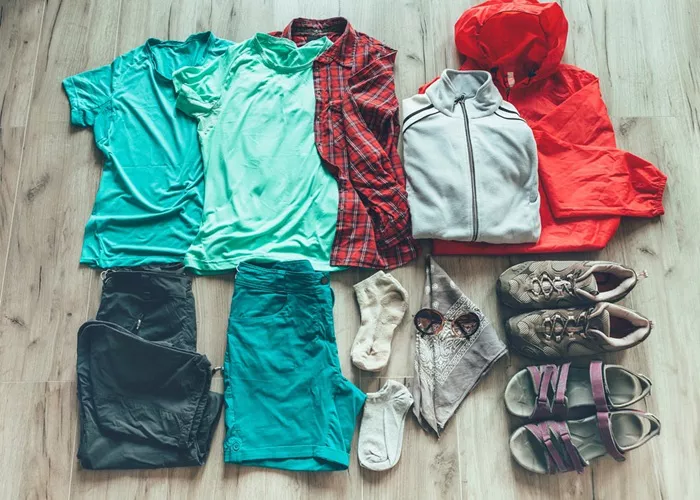Camping is all about enjoying nature, but wearing the wrong clothes can turn your trip into a struggle. The right clothing keeps you comfortable, dry, and protected from the elements. Whether you’re hiking through forests, setting up a tent, or sitting by the fire, your outfit matters.
This guide covers everything you need to know about camping attire. We’ll discuss materials, layering techniques, footwear, and weather-specific choices. Let’s dive in!
Why Your Camping Clothes Matter
Camping isn’t like a walk in the park. You face changing weather, rough terrain, and long hours outdoors. The wrong fabric can make you sweaty, cold, or even cause blisters. Good camping clothes should:
- Regulate body temperature (keep you warm or cool as needed)
- Wick away sweat (avoid staying damp)
- Dry quickly (in case of rain or spills)
- Protect from sun, wind, and bugs
- Be durable (resist tears and abrasions)
Cotton might feel soft, but it’s a poor choice for camping. It absorbs moisture and dries slowly, which can lead to chills. Instead, opt for synthetic fabrics or wool.
The Layering System: Stay Comfortable in Any Weather
Layering is the best way to adapt to changing temperatures. You can add or remove layers as needed. A good layering system includes:
1. Base Layer (The Moisture-Wicking Layer)
This layer sits directly against your skin. Its job is to pull sweat away, keeping you dry.
- Materials: Merino wool, polyester, or nylon
- Best for: All seasons (lightweight for summer, thicker for winter)
- Avoid: Cotton (holds moisture)
2. Mid Layer (The Insulating Layer)
This layer traps heat to keep you warm.
- Materials: Fleece, down, or synthetic insulation
- Best for: Cool or cold weather
- Tip: A zip-up fleece makes temperature adjustments easy
3. Outer Layer (The Protective Shell)
This layer shields you from wind, rain, and snow.
- Materials: Waterproof and breathable fabrics (Gore-Tex, eVent)
- Best for: Rainy or windy conditions
- Avoid: Non-breathable raincoats (can make you sweaty)
Best Clothing for Different Weather Conditions
Hot Weather Camping
When temperatures rise, focus on staying cool and protected from the sun.
- Top: Lightweight, long-sleeve shirt (UPF-rated for sun protection)
- Bottom: Quick-dry hiking shorts or convertible pants
- Hat: Wide-brimmed hat or cap with neck flap
- Socks: Thin, moisture-wicking socks
- Footwear: Breathable trail runners or hiking sandals
- Pro Tip: Light colors reflect sunlight, keeping you cooler than dark colors.
Cold Weather Camping
Staying warm is crucial in chilly conditions.
- Top: Thermal base layer + fleece + insulated jacket
- Bottom: Thermal leggings + waterproof pants
- Hat: Beanie (20% of body heat is lost through the head)
- Gloves: Insulated and waterproof
- Socks: Wool or synthetic blend (avoid cotton)
- Footwear: Insulated, waterproof boots
- Pro Tip: Hand warmers in gloves and boots can make a big difference.
Rainy Weather Camping
Staying dry is key to avoiding hypothermia.
- Top: Waterproof jacket with sealed seams
- Bottom: Waterproof pants (look for side zippers for easy wear)
- Footwear: Waterproof hiking boots + gaiters (to keep water out)
- Extras: Pack a dry bag for spare clothes
- Pro Tip: A poncho can double as a rain cover for your backpack.
Footwear: Choosing the Right Shoes for Camping
Your feet carry you through the trip, so good footwear is a must.
Hiking Boots vs. Trail Runners
- Hiking Boots: Best for rough terrain, ankle support, and cold weather.
- Trail Runners: Lighter, breathable, and better for warm, dry conditions.
Camp Shoes
After a long hike, let your feet breathe. Pack:
- Sandals (for warm weather)
- Water shoes (if crossing streams)
- Down booties (for cold nights)
Pro Tip: Break in new boots before your trip to avoid blisters.
Accessories: Small Items That Make a Big Difference
Hats
- Sun hat (for UV protection)
- Beanie (for warmth)
- Bandana (multi-use: sweatband, sun protection, emergency cloth)
Gloves
- Lightweight gloves (for cool mornings)
- Insulated gloves (for freezing temps)
- Waterproof gloves (for wet conditions)
Sunglasses
Polarized lenses reduce glare, especially near water or snow.
What Not to Wear Camping
Some clothes are better left at home:
- Jeans (heavy, slow to dry, uncomfortable when wet)
- Cotton T-shirts (hold sweat, increase chill risk)
- Flip-flops (no support, poor protection)
- Perfumes or scented products (attract bugs)
Final Tips for Packing Camping Clothes
- Pack extra socks (wet feet lead to blisters)
- Roll clothes (saves space in your backpack)
- Use compression sacks (for bulky items like jackets)
- Check the weather (adjust layers accordingly)
Conclusion
The right camping clothes make your trip safer and more enjoyable. Focus on moisture-wicking fabrics, smart layering, and weather-appropriate gear. Avoid cotton, pack extras, and always prepare for unexpected conditions.
Now that you know what to wear, get out there and enjoy the great outdoors!
Related topics:

